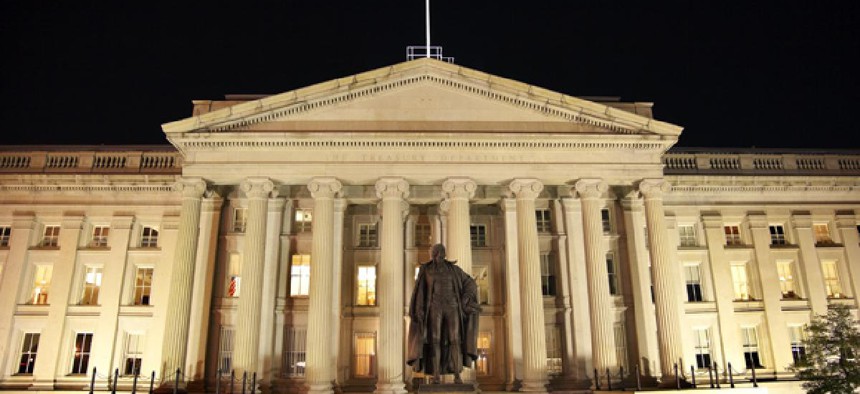
Treasury Department headquarters Bill Perry/Shutterstock.com
Treasury Refills Federal Pension Coffers
Uncle Sam makes the G Fund whole again after debt ceiling is suspended through May 18.
The Treasury Department has made whole the federal pension coffers it tapped during the latest debt ceiling debacle, according to the Federal Retirement Thrift Investment Board.
The government has reinvested $28 billion back into the government securities (G) fund, said Kim Weaver, the board’s director of external relations.
President Obama earlier this month signed into law legislation that authorized a temporary suspension of the current debt limit of $16.4 trillion through May 18, allowing the government to continue borrowing to pay its bills until then.
Treasury Secretary Timothy Geithner suspended investments into federal employees’ pensions on Dec. 31, 2012, as the government hit its debt ceiling of $16.4 trillion. The latest debt issuance suspension period lasted from Dec. 31, 2012 to Feb. 4, 2013.
The law allows the government to take extraordinary measures to avoid a default, including tapping into and suspending investments into the Civil Service Retirement and Disability Fund and halting the daily reinvestment of the government securities (G) fund, the most stable offering in the Thrift Savings Plan's portfolio. The G Fund is invested in interest-bearing Treasury securities -- bonds -- that make up the public debt. The Civil Service Retirement Fund finances benefit payments under the Civil Service Retirement System and the basic retirement annuity of the Federal Employees' Retirement System, and those investments are made up of securities also considered part of the public debt.
Federal law requires the Treasury secretary to refill the coffers of the G Fund and the CSRDF once the issue of the debt ceiling is resolved and to make up, in addition, for any interest lost on those investments during the suspension. Because of this, employees and retirees are not affected by the “extraordinary measure” designed to stave off a default.
The TSP board said Monday that it has updated its guidance on how furloughs could affect federal employees’ retirement accounts, in preparation for the upcoming sequester scheduled to take effect on Friday unless Congress makes a last-minute deal to avoid the automatic governmentwide spending cuts.
Gregory Long, the board’s executive director, said the agency is prepared to handle an increase in TSP loan withdrawals from eligible participants as a result of furloughs, and the economic uncertainty the sequester will cause for much of the federal workforce.
By the end of 2012, the TSP had about 4.6 million enrollees with $330 billion invested among its 10 fund options. Hewitt EnnisKnupp, a global investment consulting firm, completed a wide-ranging review of the TSP, concluding that “the core of the TSP’s line-up is well structured and that there are no gaps in the fund line-up offered to participants,” according to the February 2013 report.
(Image via Bill Perry/Shutterstock.com)







